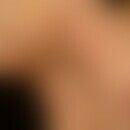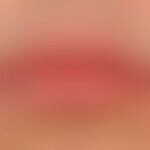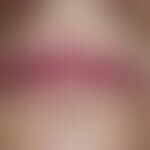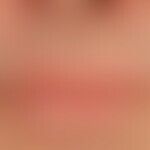Synonym(s)
DefinitionThis section has been translated automatically.
Most frequent form of a chronic, polyaetiological (but not allergic), frequently also idiopathic, but mostly irritative-toxic triggered inflammation of the lips (lip red and lip skin). Dehydration is probably the most frequent cause.
The basic symptoms are aggravated by frequent moistening of the red lips by tick-like licking (see also lip lick eczema).
A frequent drug-induced variant is the form of cheilitis triggered by isotretinoin or acitretin.
EtiopathogenesisThis section has been translated automatically.
Various triggers are discussed, in particular physical causes (wetness, cold, light), allergic genesis(cheilitis allergica), toxic-degenerative events (e.g. with constant habitual lip licking [ lip eczema]), mechanical causes (such as constant wearing of pacifiers).
Also occurring as a symptom of atopic eczema or as a side effect of internal medication (e.g. isotretinoin in acne therapy).
You might also be interested in
ManifestationThis section has been translated automatically.
w>m;
Age: Preferably adolescents and younger adults. In larger studies, the age of manifestation ranged from 9 to 79 years.
ClinicThis section has been translated automatically.
Rough, reddened, tense, painful lips with erosions, loose and adherent scales, rhagades (mostly in the middle of the lips and/or in the corners of the mouth).
Rarely small vesicles.
The symptoms often lead to the compulsive constant licking of the lips, which initially brings relief by moistening, but permanently leads to an aggravation of the symptoms.
Differential diagnosisThis section has been translated automatically.
Cheilitis can be assigned to another underlying disease. In various studies the assignments were distributed as follows:
- chronic irritant cheilitis: 36%
- contact allergic cheilitis: 25%
- atopic cheilitis): 19%
- idiopathic cheilitis: 9%
- other cheilitides: 9%.
- lupus erythematosus
- lichen planus
- perioral dermatitis.
TherapyThis section has been translated automatically.
- Greasy nourishing externals (e.g. Rolip Mandelic or Rolip Emulsion, Bepanthen Lip Cream, Ceralip Lip Cream, Lanolin Vaselinum alb. (only short-term use due to the habituation effect and the resulting increased transepidermal water loss!), ), if necessary short-term weakly effective glucocorticoids such as 0.5% hydrocortisone cream .
- In the weeping, cracked stage, moist dressings with antiseptic or anti-inflammatory additives such as 1% chlorhexidine or 2% dexpanthenol, if necessary also short-term greasy-moist treatment with a thickly applied glucocorticoid-containing ointment such as 0.5% hydrocortisone ointment, over this moist compresses.
LiteratureThis section has been translated automatically.
- Freeman S et al (1999) Cheilitis: analysis of 75 cases referred to a contact dermatitis clinic. At J Contact Dermat 10:198-200
- Gorbatova LN (2000) Atopic cheilitis in children: the risk factors and clinical symptoms. Stomatologiia (Moscow) 79:48-50
- Nagaraja Kanwar AJ et al (1996) Frequency and significance of minor clinical features in various age-related subgroups of atopic dermatitis in children. Pediatric Dermatol 13:10-13
- Wahab MA et al (2011) Minor criteria for atopic dermatitis in children. Mymensingh Med J 20:419-424
Incoming links (15)
Artifacts; Artifacts; Cheilitis; Cheilitis contact allergic; Cheilitis sicca; Cheilitis vulgaris; Contactcheilitis; Desiccation cheilitis; Eczema of the lips; Evening primrose seed oil; ... Show allOutgoing links (8)
Acitretin; Atopic dermatitis (overview); Cheilitis contact allergic; Glucorticosteroids topical; Isotretinoin; Lip lick eczema; Lupus erythematosus (overview); Perioral dermatitis;Disclaimer
Please ask your physician for a reliable diagnosis. This website is only meant as a reference.


















